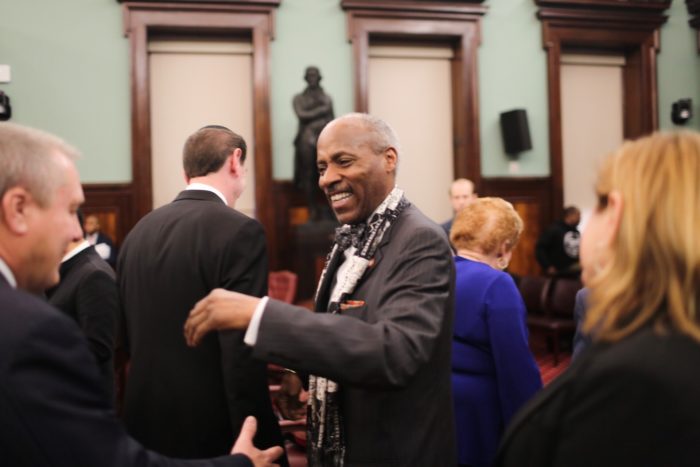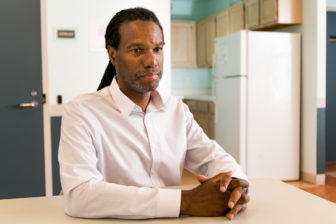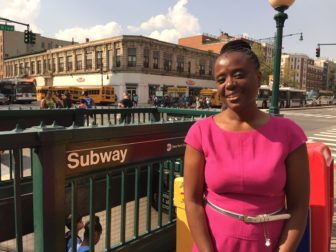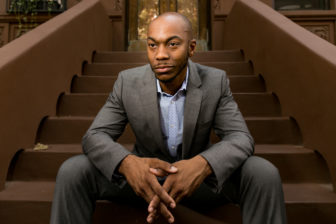
William Alatriste for the NYC Council
Perkins won a crowded, low-turnout special election to return to the Council earlier this year.
Did Harlem really mean it when they picked longtime pol Bill Perkins to serve as their councilman during the special election held last February?
Or was that just a Valentine’s Day blooper?
That’s at least what a busy field of eight challengers are hoping is the case. They point to the fact that the February 14 Special Election, held to replace Councilmember Inez Dickens, brought out only about two thirds of the voters that made it to the last Democratic primary in 2013. Now that Perkins is up for re-election, some of his challengers are running for the second time this year, hoping they’ll have more success now with better name recognition and a more normal election date. A few contenders are entirely new to the scene.
But Perkins and Harlem go way back. The 68-year-old served as the district’s councilmember from 1998 through 2005, then as its state senator from 2006 through this year. He is widely celebrated for his leadership on a host of progressive issues, including the spearheading of a 2004 bill that created stronger protections for children in homes with lead.
Perkins himself has acknowledged that he has become the “vanguard” of a crop of state lawmakers who are seeking to switch to the City Council—where the job pays $148,500 as opposed to the state’s base salary of $79,500—including Assemblymembers Robert Rodriguez, Mark Gjonaj and Francisco Moya, and Senator Ruben Diaz. He’s explained in the past that it wasn’t the higher pay that drew him back to the city, but frustration with the Republican domination of Albany. Still, some observers say that such state-to-city switches by experienced, well-known pols shut out opportunities for the development of new leadership—and certainly his challengers think Harlem needs a new direction.
“Harlem has changed a lot in the last decade alone. We look at some of the issues that we’re facing with gentrification,” says Tyson-Lord Gray, a university professor and environmental justice advocate and a fresh face in the race. “It’s not the same Harlem that [Perkins] took a seat for City Council in ’98.”
Another challenger running in the primary is Marvin Holland, the political and legislative director for the Transit Workers Union Local 100. He placed second during the February election with 2,129 ballots to Perkins’ 3,933.
The Council faces the threat of a major loss in female leaders this election cycle, and there’s currently only one female in the busy field of District 9 challengers: Cordell Cleare, the district leader who served for 10 years as Perkins’ chief of staff, and came in fifth in the February election with 1,101 ballots.
And there’s two more Dems who will be on the primary ballot for the first time this year: Community activist Julius Tajiddin, who runs a music publishing company and has served on school leadership teams and as a public member of local community boards, and Marvin Spruill, who is running on an anti-gentrification platform.
In the February election, Holland tried to clear the field by raising objections to all of his opponents’ petitions. This time around, Holland’s objections removed lawyer and former teacher Pierre Gooding from the Democratic ballot, but Gooding will be on the November ticket as the chosen Reform Party candidate (Gooding also ran for the special election but quit that race on his own accord).* Dianne Mack, also removed from the Democratic ballot, and Republican Jack Royster Junior also plan to run in the general election.

Adi Talwar
Candidate Marvin Holland
Beyond name recognition and his status as an incumbent, Perkins has a modest financial advantage over his opponents. While the $44,500 he raised is not a massive war-chest as Council races go, it was 70 percent more than his closest fundraising rival. He also received more in public matching funds than anyone else in the race, although three of his challengers also qualified for public money. Right now, Perkins has the most cash on hand ($72,482), with Cleare ($54,851), Gray ($39,697) and Holland ($21,720) also in the mix.
City Limits spoke to a number of candidates to hear their visions for the future of Harlem and discovered that many of them are concerned about the same issues: affordability and housing, access to good-paying jobs, environmental problems, and the quality of Harlem’s schools. Their differences lie in their approach to solving those problems, and most of all in the types of experiences they would bring to the job.
A variety of backgrounds
Perkins comes with credentials: he was named one of the eight most progressive city leaders by The Nation in 2005. City Limits found that in his two prior terms in the Council he was the primary sponsor of 17 bills and 103 resolutions. The councilmember’s website points to a variety of issues that he’s fought for, from funding for public education and healthcare access, to addressing the rat epidemic and raising the minimum wage. He was one of the first New York leaders to stand up against the war in Iraq. Already a number advocacy organizations have lined up to give their backing, from Tenants PAC to the LGBTQ rights organization Stonewell Democrats—and, of course, his former colleague in the Council, Mayor Bill de Blasio.
The shortness of Perkins’ current City Council term makes it difficult to judge his work as of late: City & State’s performance rankings for all councilmembers excluded Perkins for this reason. A legislative review of this year indicates he has not been the primary sponsor of any bills or resolutions, but has co-sponsored 10 bills.
“I think we’ve done some good work with the budget, in terms of focusing the resources that are available to some of the concerns that have come to our attention in terms of public education,” said Perkins when asked what he was most proud of accomplishing in his first few months back on the Council. “There’s a question of affordability that we’ve tried to help address in terms of what does that really mean in comparison to what people’s needs are.”
He continued: “We have a wealth, so to speak, of small businesses in the neighborhood, bodegas, other small enterprises that we try to make sure that we’re in touch with and see how can we bring support to them. You know we’ve had a history in terms of police community relations that has at times been very divisive. We want to make sure that we’re engaged…in touch with what’s happening on the street, what’s happening with the police.”
He repeatedly mentioned that political change is “not like instant coffee”—that improvements are the results of years of advocacy and gradual change.
Holland, however, says Harlem needs new energy. “People are living off of what [Perkins] did over two decades ago,” he says. Holland, who began his career at the union cleaning train stations before rising to legislative chief, says he knows how the legislative process works after spearheading the advocacy that passed two worker-protection bills through Albany. “My track record of getting things done speaks for itself,” he says. He also serves on the boards of a number of local community and tenant advocacy organizations, and says he wants to launch participatory budgeting in Harlem—where constituents vote on how discretionary funds are spent. In February, Holland received the endorsement of the Working Families Party and was widely described as the “union-backed” candidate, but this time around he says he’s focusing more on getting buy-in from Harlem constituents—and WFP and a couple of those unions have lined up behind the incumbent instead.
Cleare, who received the Amsterdam News’s endorsement last February, has been female district leader since 2007, and also served on the Community School Board for District 3 and the Community Education Council. Her advocacy on lead began in the early 1990s, when her own son was poisoned, and she brought the issue to Perkins’ attention as a member of his staff, as Perkins himself acknowledges. Having lived on the same block for 40 years, her connections are deep. “I went this weekend to many different events and we ran into tons of people who I’ve worked with over the years,” she says. “This community taught me everything I know about activism and about advocacy and about working for and serving this community,” she says.
Gray, a native of Georgia, has lived in the district for eight years, excluding shorter stays in earlier years, but he has bona fides of his own sort: four graduate school degrees, including a ministry degree and a recent one in environmental law. He’s the founder of Green Community Vision Inc. (a nonprofit that aims to address environmental issues in minority communities), has formed relationships with neighborhood organizations like Harlem Grown and local churches, and has experience providing pro-bono services to the Legal Aid Society and assisting people with public benefits. Gray says the mobilization of citizens following Trump’s election inspired him to move into politics. “How do we play a vital role in resisting a lot of those policies that are coming down from the federal level?” he says. “There is so much work that can be done on a local municipal level prior to the next presidential election.”
Moreover, whether they are politician or a union man, a longtime resident or a more recent one, the candidates vying for District 9 offer a variety of perspectives on the issues that are most pressing in Harlem.
The affordability crisis
Probably most pressing in Harlem is the issue of affordability. From 1990 to 2010-2014, Harlem’s rents increased by 53.2 percent, a rate second only to Williamsburg. At a recent town hall hosted by Perkins and de Blasio, constituents raised a variety of housing-related concerns. There was discussion of the Tenant Interim Lease, under which the city took over abandoned buildings with the goal of eventually helping tenants become co-operative owners. Over the years, some TIL buildings been successfully converted to cooperatives called Housing Development Fund Corporations (HDFCs) while others have faced a number of difficulties converting. There was also discussion of the best way to support existing HDFCs, fund repairs in NYCHA’s aging public housing stock, and create deeply affordable housing for the homeless.
Perkins says he’ll continue to press the mayor on the importance of redefining affordability to meet people’s actual needs, and press the state and federal government for more resources to build housing that is truly affordable to Harlem residents. Asked for his thoughts on TIL and HDFC buildings, he says they have helped stabilize the neighborhood and provided real affordability, and must be sustained. Asked about “infill development,” the de Blasio administration’s plan to allow developers to construct housing on NYCHA property in order to fund NYCHA repairs, Perkins says he has some concerns: NYCHA was intentionally designed with plenty of open space for its residents, but “that vision is obviously threatened” when developers see a lot of money can be made from that space, he says, and such deals should be monitored closely.
Holland says that he’d convene an advisory council of community leaders to create a plan for solving housing issues in the district. He places an emphasis on the importance of affordable homeownership and providing support to HDFC and TIL buildings, and thinks the city’s attempt to impose a price cap on the sale of units in already-established HDFCs was misguided. He also says he’s advocating for the creation of a “housing legacy program” that would fill vacancies in TIL program buildings with long-term Harlem residents. Community land trusts are also one of his priorities, and he wants to provide support to religious organizations that have difficulty maintaining their affordable housing inventory. Like Perkins, he is skeptical of infill development.

Abigail Savitch-Lew
Candidate Cordell Cleare
Cleare is first and foremost against the “privatization of public housing,” or infill development. Though rent regulation is a state-controlled issue, she says she’d fight to make Albany strengthen its rules to stem the rapid depletion of the city’s rent-stabilized housing stock. She says there shouldn’t be a one-size-fits-all solution for HDFCs, and that the city needs to place a moratorium on the movement of TIL buildings to the Affordable Neighborhood Cooperative Program (ANCP) program. (Under ANCP, TIL buildings, which are city-owned, are transferred to private developers that rehabilitate the property, but the tenants are required to take out a mortgage and to pay more money to become cooperative owners.) Cleare also stresses the importance of creating affordable commercial spaces for neighborhood entrepreneurs and on her website calls for more income-targeted housing.
Gray calls for building mixed-income and low-income housing—apartments that Harlem residents can actually afford, but without “concentrated poverty.” He also will fight for more funding for NYCHA repairs, he says—and of the NextGen NYCHA plan for infill development, he says, “on the face, it sounds like it would be a good idea.” He professes a strong concern about the city’s lack of investment in TIL buildings and a prevalence of vacancies in TIL buildings, especially commercial vacancies. “We’ve got to find ways to shore that program up, we’ve got to find ways to ensure those individuals who are living there have enough extra money being generated [for] the upkeep of their building,” he says.
Inferior schools
Over recent years, Harlem has seen a crop of new charter schools, but the performance of traditional public schools have improved only marginally: in terms of fourth grade English Language Arts (ELA) scores, Harlem placed 56th out of the 59 community districts in 2016.
Perkins, known as an an outspoken critic of charter-schools, says that charters were supposed to be laboratories for educational experimentation, but that the public needs more answers about what charter schools have actually achieved and what lessons can be applied to public schools. He proposes a report to find out what charters have figured out and to hold them accountable for the resources they’ve received.
Similarly, Gray and Cleare stressed that students in traditional public schools are being left behind and there needs to be more investment in those schools, with Gray even blaming Perkins for the rise of charter schools in the district over the past few decades. (It’s up to the Department of Education, however, to decide where to place charter schools.)
Holland’s website says he would focus on “Strengthening our schools with more parental involvement, expanding after school programs and vocational education options.”
The unemployment rate
Harlem’s unemployment rate is not as bad as it used to be, but still a challenge, declining from 18.61 percent in 2000 (5th highest in the city) to 11.61 percent today (9th highest).
Tackling it is one of Holland’s biggest priorities. He says he’d support more technological training and initiatives along the lines of Silicon Harlem, which supports local tech entrepreneurs. He also sees possibility for job growth through the employment of local residents to fill neighborhood-level services: expanding the Harlem Grown composting system to meet the needs of local farmers and restaurants, tackling the neighborhood’s rat infestation by employing people to pick up trash, and employing residents to make NYCHA repairs, among other ideas.
Cleare stressed the importance of directing more resources to local entrepreneurs and small businesses. Similarly, Gray’s website says he will “work to support local businesses by directing funds into programs that support small businesses and help grow Harlem’s economy.”
Asked what he would do to respond to the community’s need for jobs, Perkins says, “Some of what we do legislatively we see from the perspective of how many jobs are being created.” He also says that he communicates with the mayor and other levels of government to find job-creating opportunities.
Asthma, rats, and food access
Harlem has the 10th highest child asthma rates in the city. While better than some outer-borough neighborhoods, Harlem families also have the worst meal gap—number of meals forgone—in Manhattan, and it’s grown worse in recent years, increasing by seven percent from 2012 to 2014. In addition, everyone’s complaining that the neighborhood’s rat epidemic is back.

Adi Talwar
Candidate Tyson-Lord Gray
Gray says he would address access to fresh and affordable food by providing incentivizes for affordable supermarkets, bringing more farmers markets and Community Supported Agriculture (CSA) programs to Harlem, advocating for kiosks at Farmers Market to enable the use of SNAP benefits, and encouraging private organizations to agree to match dollar for dollar when SNAP benefits are used at Farmers Markets and CSAs. He also hopes to use his relationships with Harlem’s faith-based communities, many of which he notes already run pantries, to develop partnerships that tackle the issue of food access and injustice. He says he will advocate on behalf of Harlem to the Department of Sanitation to actually do scheduled pick-ups, which he says are often missed, and potentially explore the addition of more pick-ups. He emphasized that it was the responsibility of the councilperson to ensure that their district received only a fair share of air-polluting facilities.
Cleare says she’d work to ensure any new economic development projects have space for affordable supermarkets, that she’ll be a watchdog to ensure air-polluting facilities are not sited in the district, and she’d work to ensure the mold and lead laws are properly enforced and that tenants have an easier time asking for help if they suspect their apartment may contain lead. “There are many things in the way and it shouldn’t be so much onus on tenants and everyday citizens to have to know all these very technical things and all these processes and procedures. It should be on government to enforce what is right to protect the people,” she says.
Perkins is also concerned about the rat problem, and agreed that improving access to affordable healthy food is important, but took issue with the depiction of Harlem offered by some other candidates. “This is not a ‘desert’ version of Harlem. This is a different era,” he says.
*Correction: Originally stated that Gooding was removed from the ballot in February. In fact, he quit the race of his own accord.
Faith in New York will hold a city council candidate forum for District 9 on September 7 at 7:00 p.m., RC Lawson Building 3rd floor, 130-136 West 124th Street, Manhattan.









5 thoughts on “Harlem Race is a Test for Council’s Newest Incumbent”
A lot is left out about Julius Tajiddin. I ran for City Council in 2009 in District 7.
Holland challenged me to be on the ballot through a ghost citizen objector and initially prevailed. I went to court and won my right to remain on the ballot. His lawyer and the BOE called my lawyer to tell them they weren’t going to show up because they felt they would not win. That cost me $5400.
Also I co-founded Harlem4Obama; orchestrated Barack Obama’s historic visit to the Apollo in 2007; co-created the city-wide Neighborhood Coordinating Officers Community Policing Program which has resulted in a great reduction in stop and frisk stops; led the fight that stopped the DOE from closing the Wadleigh School and FDA 2’s middle schools down, as I was the Chair of FDA2’s SLT at that time and the Co-chair of the campus SLT; helped ACS form a community partnership known as the Community Representative Program, where community representatives sit in on child safety conferences – this has resulted in a reduction of unfair child removals;
Negotiated with DHCR officials in 2008 to change an unconstitutional Preferential Rent Policy that had caused 17,000 people from being self evicted in West and Central Harlem, which resulted in saving over 30,000 Rent Stabilized apartments between 2008-2012; forced NYCHA to scrap an unjust Section 8 program that would have caused 24,000 residents to lose their apartments. In fact, not only do I oppose NYCHA’s Next Generation I am spearheading the challenge to it. The counter proposal is called NYCHA’s Legacy for the Future Manifesto, which was chiefly drafted by me. I am a key player in Community Board 10’s NYCHA Task Force subcommittee.
I am not only the main supporter of Harlem’s Street Vendors, I have successfully organized them. We now have about 40 members enrolled in the Harlem Street Merchants Association.
Citi Bike (Bike Share) Stations will not be on 125th Street (at least in CB 10) nor on any street because of me. By this not happening Vending spaces and our precious free parking spaces have been preserved. This was all in the news too.
I led the fight to stop the City from reconfiguring Harlem’s historic [7th Avenue] also. See the Daily News story and AM News, “Harlem Street Fighter.” written by the late Michael Feeney.
I was also honored this year by Community Board 10. I received the Outstanding Citizen Achievement Award for the month of April.
I was a key leader in the fight against the 125th Street Rezoning and Columbia Expansion Plan. The vision of Sky Scrapers, mainly Luxury Housing, on 125th Street has been derailed by mechanisms that were placed into the Zoning that were largely drafted by me. I wrote major components to the Community Benefits Agreement between Columbia and West Harlem Development Corporation, the local body that negotiates and operates on behalf of Manhattanville Residents.
Charter School co-locations in Central Harlem slowed down as a result of my work.
There is a record of 16 years of productive and successful activism by me and all you can mention is a two-liner? You talk more about Johnny Come Latelies and discount – by your omissions – all the work that I put in to the Harlem Community. And this is why Trump calls it Fake news.
I dare anyone to challenge me on anything I said where the discussion is about my track record and I will crucify them.
Yes, I am a little dismayed to say the least.
You should be thanking them for leaving out a lot of your bio- especially your shameful opposition to life saving 7th avenue safety fixes, not to mention CitiBike. The vast majority of people in Harlem DO NOT drive- affordable transit options for residents (including discounted rates for NYCHA residents) are much more important than ‘precious’ free parking spots for you and the Harlem elite.
Ditto, just looked him up and… troubling.
Here, here Julius. There was a stench of favoritism in the story.
Pingback: Our choice for New York City Council | Beesquared